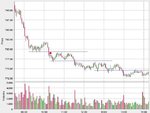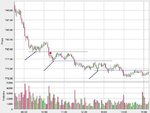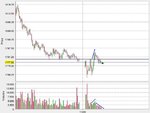oldbull said:
As I get started on my new quest, I would like to know if there are some particular readings, articles, pdf’s etc.. on this site that anyone can recommend to get me started in the correct direction. I have been down the wrong path long enough.
Thank you in advance
In addition to the fifth post in this thread, the following may be of help. As for your comments re "The Mirror", I'm glad you understand why I chose to title the thread as I did. The mirror is also a metaphor for the chart, given that we more often see what we want to see rather than what's really there.
Reversals
Mark Douglas
After a certain period of time, you can notice how trending markets will develop a certain rhythm and flow, making the price movement look very symmetrical on a bar chart. You really don’t have to know why this is so, you just have to notice that it exists. When this flow is broken (the market trading above or below a significant trend line), it is a good indication the balance of the market forces has shifted. Then ask yourself, what is the likelihood the shift will gain hold and continue trending in the direction of the break?
You don’t even have to know the answer to that question. Put in an order at a spot that would confirm the highest probability of a change in the balance. Then wait for the market to define itself. If your order is filled, put a stop where the market shouldn’t be to confirm that your trade is still valid. “What is a valid trade?” you ask. One where the highest probabilities for price movement are in the direction of the prevailing force.
I will give you an example.
No matter how simple a trade this is, it has very sound psychological reasons for working. In this example, the market made new highs and sold off. The sell-off could be the result of new sellers coming into the market in force, or old buyers selling to take their profits, or a combination of both. Prices will continue to drop until enough traders believe the price is cheap and are willing to take the initiative and bid the price back up. As the price approaches the last previous high, buyers will begin to anticipate whether or not prices can penetrate, and sellers will be looking for a top.
In either case expectations by both will be raised. If some buyers are willing to bid the price past the previous highs to some significant level, it will make believers out of others who were on the sidelines. If they do come in, it will add to the momentum. Some old sellers will admit to being wrong and will have to buy to get out of their trades, thus adding to the upward momentum.
However, what if the market approaches the highs the second time, and sellers come back into the market again with enough force to keep the price from exceeding or equaling the previous high? Buyers will start to become disappointed. Where will they really be disappointed? — if enough buyers don’t come into the market to support the price at the previous low. If prices penetrate that low, watch for buyers to bail out en masse. For them to get out of their position, who is going to buy it from them? If everybody is trying to sell and no one is available to buy, what are prices going to do? Fall like a rock.
The reason why a bull market is ready to turn into a bear market when the general public gets involved is because the general public has the least tolerance for risk and consequently needs the most reassurance and confirmation that what they are doing is a sure thing. As a result, they will be the last to be convinced that the rising market represents an opportunity. If a bull market has lasted for any length of time, the general public will feel compelled to jump on the bandwagon so to speak, because of their perception that everyone else is doing it and making money. They will pick up on any reason that sounds the most rational to justify their participation, when in reality, they will know very little about what they are doing, but since everyone else is doing it, how can they go wrong.
A continuing bull market requires the continual infusion of new traders who are willing to pay higher and higher prices. The longer a bull market lasts, the greater the number of people who are already participating as buyers, leaving fewer and fewer traders who haven’t already bought and fewer and fewer traders who are willing to bid the price up. These older buyers obviously want to see the market keep on going up, but they also don’t want to get caught holding the bag, if the market stops going up. As their profits accumulate from the higher prices, they start to get nervous about taking their profits.
By the time the general public starts buying en masse, the professional traders knows the end is near. How does the professional know this? Because the professional knows that there is a practical limit to the number of people who will participate to bid the price up. There will come a point where everyone who is likely to be a buyer will have already bought, quite literally leaving no one else to buy. The professional trader would like the market to continue to go up indefinitely just like all the other buyers. However, he also understands the impracticality of that happening, so he starts taking his profits while there are still some buyers available to sell to. When the last buyer has bought, the market has no place to go but down.
The public gets stuck because they weren’t willing to take the risk when there was still potential for the market to move. For the market to sustain itself, it needs to attract more and more people. As big as this country is or the world for that matter, there are only so many people who will buy. Eventually the supply of buyers runs out, and when it does the market falls like a rock.
The professionals have been selling out their positions before this happens, but once the supply of buyers runs out, the professionals start to compete among one another for the available supply of buyers which is dwindling fast, so they offer lower and lower prices to attract someone into the market so they can get out. At some point, instead of the lower prices being attractive to people, it panics them. The public didn’t anticipate losing. Their expectations are very high with very little toleration for disappointment. The only reason they got in was because it was a sure thing. When the public starts to sell, it starts a stampede.
Again, people will ascribe their actions to some rational reason because nobody wants to be thought of as irrational and panic-stricken. The real reason why people panicked and the prices fell is simply because prices didn’t keep on going up.
[Note: This excerpt is somewhat edited from Douglas's book, and I replaced the original image with one of my own which to me illustrated the concepts more clearly.]




